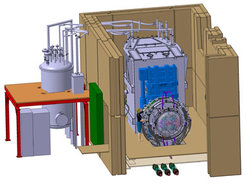ELISE testing new type of heating for ITER
IPP develops heating system for the ITER fusion test reactor / agreement signed

The two particle beams that are to heat the 800 cubic metres ITER plasma to many million degrees each have a door-size cross-section. Each of them is to pump a heating power of 16.5 megawatts into the plasma. It is a “huge step” to be taken from today’s plate-size cross-sections to attain this order of magnitude, states Dr. Peter Franzen, who is working at IPP on the development of the heating system for ITER. Like the sun, a future fusion power plant is to derive energy from fusion of atomic nuclei. For this purpose the fuel, a hydrogen plasma, has to be confined in a magnetic field cage without touching the vessel wall and be heated to the ignition temperature of over 100 million degrees. The ITER (Latin for “the way”) test device being built at Cadarache in France as an international cooperation is to show that an energy-yielding fusion fire is possible. It is to generate a fusion power of 500 megawatts, this being ten times as much as will be needed to heat the plasma beforehand.
About half of this plasma heating will be provided by the so-called “neutral particle heating”: Fast hydrogen atoms injected into the plasma collide with the plasma particles and transfer their energy to them. Today’s devices thus attain several times the sun’s temperature at the press of a button. The ITER large-scale device, however, imposes new requirements on the proven method. For example, the particles have to be three to four times faster than hitherto, so that they can penetrate deep enough into the voluminous plasma. A particle source developed at IPP was incorporated in the ITER design in 2007. After successful prototype development the European ITER agency, Fusion for Energy, has now also awarded IPP the contract for adapting the heating system to ITER’s requirements.
IPP at Garching is therefore now building a new test rig for investigating a source half the size needed for ITER instead of the previous smaller prototypes. The increasing size accordingly calls for revision of the previous technical solutions for the elements of the ion source. After two years of construction ELISE will spend two years testing whether the newly designed large ion source can produce a particle beam approaching ITER’s requirements. The system in its original size will then be investigated by Italy’s ENEA fusion institute in Padua. ELISE and its Italian successor are firmly integrated in ITER’s time schedule: The neutral particle heating will have to function from the test reactor’s first day of scientific operation.
Isabella Milch
